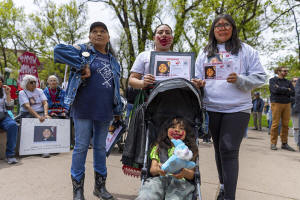Indigenous people raise awareness about their missing and murdered
[May 05, 2025]
By MICHAEL WARREN
Indigenous people across North America are calling this week for
sustained responses to the violence in their communities, much of it
against women and girls.
In prayer walks, self-defense classes, marches and speeches at state
capitols, they are pushing for better cooperation among law enforcement
agencies to find missing people and solve homicides that are among about
4,300 open FBI cases this year.
Some parents say they will use Monday's Missing and Murdered Indigenous
Persons Awareness Day to make sure children understand what's at stake.
Many young women are covering their mouths with bright red handprints,
vowing to speak for those who have been silenced. According to the U.S.
Justice Department, Indigenous women are more than twice as likely to be
victims of homicide than the national average.
What ‘the talk’ means to Indigenous people
Lisa Mulligan, of the Forest County Potawatomi, carries this message
when she rides her motorcycle from Wisconsin to rallies out West. She
plans to give her two granddaughters “the talk” as they grow older about
what they statistically might encounter in their lives.
She will warn them that her father was killed and another relative was a
victim of sex trafficking.
“That’s why I ride for it,” Milligan said. “I don’t want it to happen to
anyone else.”
Christina Castro, of Taos Pueblo in New Mexico, has a 12-year-old
daughter. Navajo Nation citizen Joylana Begay-Kroupa has a 10-year-old
son. They also have shared anguished reality checks, hoping to protect
their children and foster change.

“Indigenous people don’t have the luxury about NOT talking to our
daughters about violence against girls. I’ve had to talk with my
daughter since birth about bodily autonomy,” said Castro, who co-founded
the advocacy organization 3 Sisters Collective in Santa Fe, New Mexico.
The collective is hosting self-defense training and speeches at the
Arizona capitol, and showing part of the documentary “She Cried That
Day," about the 2015 unresolved death of Dione Thomas, a Navajo woman.
Self-defense classes also will start soon at the Phoenix Indian Center,
a social services hub for Indigenous people.
“I always go into auntie mode. You automatically want to protect your
nieces and your nephews and your children," said Begay-Kroupa, the
center's chief executive. “Unfortunately in Indigenous communities,
we’ve seen this type of suffering occur over and over again.”
She said she doesn't hold back information when speaking with her young
son.
“We have relatives that have gone missing, and we just don’t know where
they’re at,” Begay-Kroupa said. “He wants to understand why, where’d
they go and what happened to them.”
[to top of second column]
|

Relatives of Darian Nevayaktewa, a member of the Pueblo of Tesque
who went missing on the Hopi Indian Reservation in 2008, raise
awareness about his disappearance at a rally in Santa Fe, N.M.,
Sunday, May 4, 2025. (Nilaya Sabnis via AP)

Yaretzi Ortega, a 15-year-old from the Gila River Indian Community
who wore the red handprint Saturday, said Native Americans need to
speak up every day. It's a message she understood when she too got
“the talk.”
“People need to be aware at a young age because it could happen to
them," Ortega said. "‘The talk’ is an acknowledgment of how Native
American women and children have often been targeted. They have to
be aware of the risks.”
Indigenous men aren’t immune. Donovan Paddock, who joined an
awareness walk Friday in Scottsdale, Arizona, said two of his uncles
were killed. His grandfather Layton Paddock Sr., a Navajo Code
Talker, was found dead months after going missing in Winslow.
“My passion now is to help those that can’t find their loved ones,”
Paddock said.
Years of advocacy have produced slow results
Some tribes have invited federal teams to lead simulation exercises
showing what to do if someone goes missing.
Fully implementing Indigenous Alerts as part of state AMBER Alert
systems will require more resources and coordination with the 574
federally recognized tribes, Navajo Nation Council Delegate Amber
Kanazbah Crotty said.
Tribal alerts only recently became eligible for federal funding, and
tribes had to lobby the Federal Communications Commission before
Apple upgraded iPhones to accept them, Crotty said.
Pamela Foster, a Navajo woman, has been a strong advocate since the
delayed response to the 2016 kidnapping and murder of her daughter,
Ashlynne Mike. Several years later, 76% of the tribes responding to
a survey said they were participating in state alerts, but some
state coordinators said they still didn't even have tribal contact
information.
The Trump administration in April announced a surge of FBI resources
to 10 field offices to help the Bureau of Indian Affairs' Missing
and Murdered Unit and tribal police prepare cases for prosecution.
The 2023 “Not One More” recommendations commissioned by Congress no
longer appears on the Justice Department website, but still can be
seen at the National Indigenous Women's Resource Center. In it,
former Interior Secretary Deb Haaland noted over 84% of Native
American men and women experience violence in their lifetimes.
___
Associated Press journalist Matt York in Scottsdale, Arizona,
contributed to this report.
All contents © copyright 2025 Associated Press. All rights reserved |